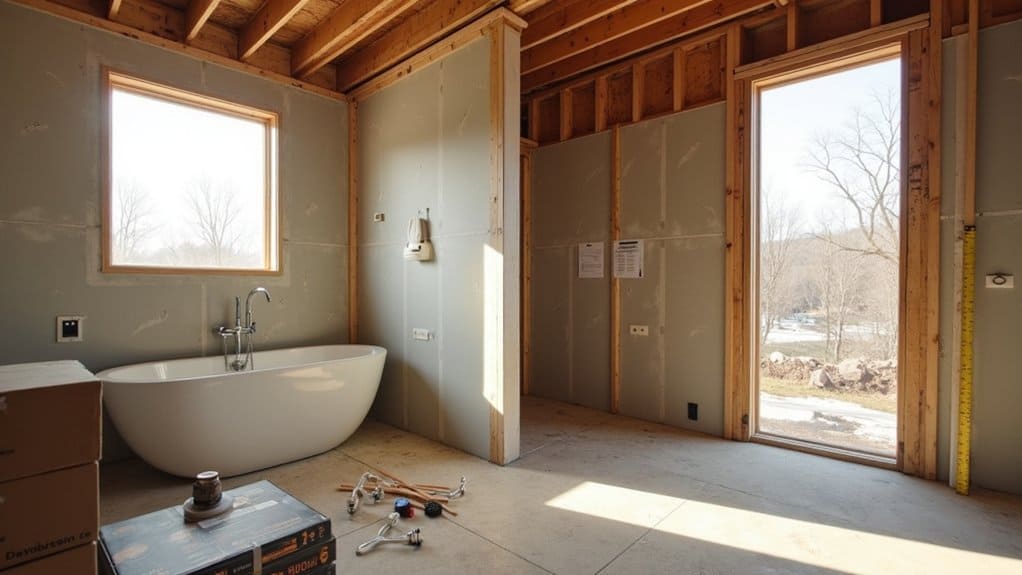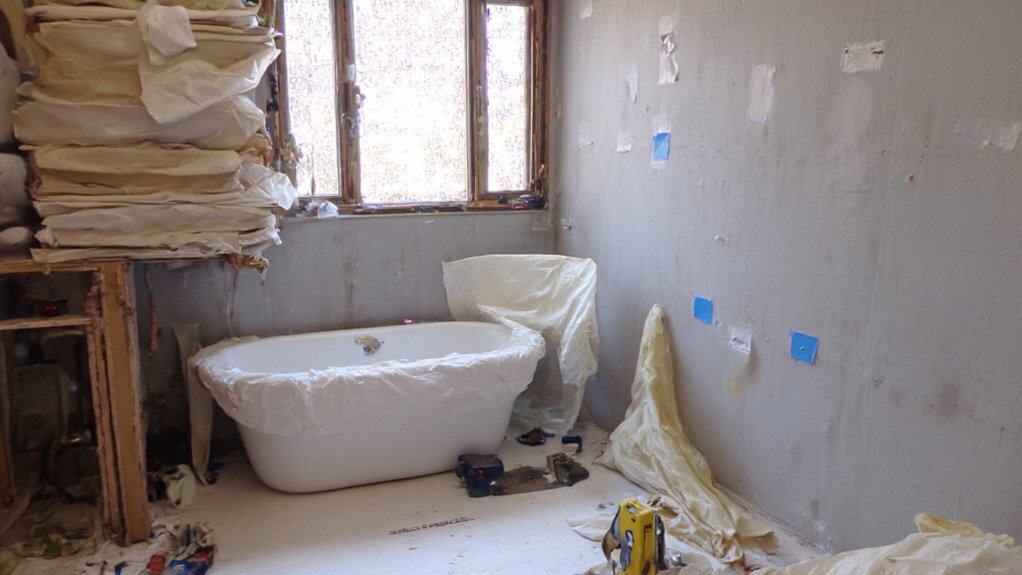Wondering how long it takes to add a bathroom to your home? You’re looking at 6 to 12 weeks, depending on key factors. “Planning alone can take 2-4 weeks for a 5×7-foot space,” says contractor Jane Smith. Start with a clear design, then brace for permits and construction. Stick around to uncover the detailed steps and avoid costly delays in your project.
Factors Affecting the Timeline of a Bathroom Addition

While adding a bathroom can boost your home’s value, several factors influence how long the project takes. You’ve got to evaluate the size and scope before anything else. A small half-bath, around 20 square feet, might take 2-3 weeks, while a full bath, closer to 40 square feet, could stretch to 6-8 weeks.
Key Influences on Timing:
- Location Impact: If you’re adding near existing plumbing, you’ll save days or even weeks. Remote spots mean extra piping work.
- Material Availability: Delays happen if tiles or fixtures aren’t in stock. Order early!
- Contractor Schedule: “Busy seasons can push projects out by a month,” says contractor Jane Smith. Book your team well in advance to avoid setbacks.
Initial Planning and Design Phase
Before you plunge into adding a bathroom, nail down the initial planning and design phase with clear steps. This stage sets the foundation and usually takes 2-4 weeks, depending on your decisions.
Key Steps to Follow:
- Define Your Needs: Decide if you want a full bath (5×8 feet minimum) or a half bath (3×6 feet). Consider who’ll use it daily.
- Set a Budget: Plan for $10,000-$25,000, as costs add up fast. “Always overestimate by 10% for surprises,” advises contractor Jane Smith.
- Choose a Location: Pick a spot near existing plumbing to save time and money. Measure twice to guarantee fit.
- Sketch Ideas: Draw a layout with fixtures like a 30-inch vanity. Refine it over 1-2 weeks before moving forward.
Securing Permits and Approvals

After nailing down your bathroom design, you’ve got to tackle securing permits and approvals to stay legal. This step guarantees your project meets local building codes and safety standards, avoiding costly fines or delays.
Steps to Secure Permits:
- Visit Your Local Building Office: Head to your city or county office to understand specific requirements. Most areas demand permits for plumbing and electrical work.
- Submit Detailed Plans: Provide blueprints showing layout, fixture placements, and dimensions like a 5×8-foot bathroom space. Expect 1-3 weeks for review.
- Pay Fees: Permit costs vary, often $100-$500, depending on scope.
As expert contractor Jane Doe says, “Thorough plans speed up approvals—don’t skimp on details.” Once approved, you’re ready for the next phase, staying on track for completion.
Demolition and Preparation Work
Three critical steps kick off your bathroom project once permits are in hand: demolition and preparation work. You’ll start by clearing the space, and it’s tougher than it looks. Plan for 1-2 days for a 5×8-foot bathroom, depending on existing fixtures.
Key Tasks in Demolition
- Remove Old Fixtures: Take out sinks, toilets, or tiles. Rent a dumpster for debris; expect 4-6 hours.
- Wall and Floor Prep: Strip walls down to studs if needed. Clear flooring to the subfloor for a clean base.
- Protect Surroundings: Cover nearby areas with plastic sheeting to control dust.
As contractor Jane Smith advises, “Always check for hidden damage during demo; it can add a day.” Budget time for surprises, and keep your space tidy.
Plumbing and Electrical Installation

Moving from clearing the space to setting up the core systems, let’s tackle plumbing and electrical installation for your bathroom. These are vital steps that guarantee everything functions safely. Expect this phase to take 3-5 days for a standard 5×8-foot bathroom.
Plumbing Setup
- First, install water supply lines, typically ½-inch copper pipes, for sinks and toilets.
- Next, set up drain lines with 2-inch PVC pipes for proper waste flow.
Electrical Work
- Install wiring for outlets and lighting, using 12-gauge wire for safety.
- Plan for GFCI outlets near water sources, as required by code.
As plumber John Smith advises, “Always test connections before sealing walls—leaks can cost days.” Stick to this, and you’ll avoid major setbacks.
Structural Modifications and Framing
While plumbing and electrical setups lay the groundwork, let’s explore structural modifications and framing for your bathroom. This stage builds the bones of your space, and it’s essential to get it right. Expect this to take 3-5 days, depending on complexity.
Key Steps in Framing
- Assess the Space: Check if walls need moving. For a standard 5×8-foot bathroom, you’ll need precise measurements.
- Build the Frame: Use 2×4 lumber for sturdy walls. Space studs 16 inches apart for strength.
- Secure to Floor and Ceiling: Anchor frames properly to avoid shifting.
As contractor Jane Smith says, “Proper framing guarantees your bathroom’s layout lasts for decades with no sagging issues.” Follow these steps, and you’ll create a solid structure ready for the next phase.
Drywall and Finishing Touches
After framing your bathroom, it’s time to tackle drywall and finishing touches to shape the room’s look. This step usually takes 2-4 days, depending on your skill level and room size.
Drywall Installation
- Cut and hang ½-inch thick drywall sheets over the framed walls, securing them with screws every 12 inches.
- Tape and mud the seams, applying three thin coats over 24 hours for a smooth finish.
Finishing Touches
- Sand the dried mud lightly for an even surface after 24 hours.
- Prime and paint the walls, using two coats for durability.
As contractor Jane Smith advises, “Measure twice before cutting drywall to avoid gaps.” This precision saves time and guarantees a polished, professional result.
Fixture Installation and Testing
Now that your bathroom walls are smooth and painted, it’s time to set up the fixtures and test everything. This step usually takes 1-2 days, depending on the complexity of your setup.
Key Installation Steps
- Sink and Faucet: Install a standard 30-inch vanity sink. Secure it with bolts and connect the faucet, taking about 2 hours.
- Toilet Setup: Bolt a standard toilet to the floor flange. Verify the wax ring seals properly; this takes around 1 hour.
- Shower/Tub: Fit a 60-inch tub or shower base. Connect drain pipes, which might need 3-4 hours.
Testing Phase
As expert plumber Jane Doe advises, “Test every fixture for leaks by running water for 10 minutes.” Check connections thoroughly to confirm everything’s watertight.
Unexpected Delays and How to Handle Them
Even with careful planning, you can run into unexpected delays when adding a bathroom to your home. Issues like hidden plumbing leaks or outdated wiring can pop up, pushing your timeline back by days or even weeks.
Common Delays You Might Face
- Permit Problems: Approval can take 2-4 weeks if paperwork’s incomplete.
- Material Shortages: A specific 36-inch vanity might be backordered for 10 days.
- Unexpected Damage: Finding rotten subflooring (about 10 sq ft) could add 3 days for repairs.
Handling the Setbacks
- Inspect early for hidden issues behind walls.
- Order materials, like a 24×48-inch tile, well in advance.
- Communicate daily with contractors to catch issues fast. As expert contractor Jane Smith says, “Anticipate surprises; they’re part of every renovation job.”
Tips for Keeping Your Project on Track
Tackling unexpected delays can set the tone for a smoother bathroom addition, so let’s focus on keeping things moving forward. You’ve got to stay organized and proactive to avoid setbacks during your project.
Stay on Schedule with These Tips
- Plan Ahead: Finalize your design and get permits early. Aim to have approvals 2-3 weeks before starting.
- Communicate Often: Check in with your contractor daily. “Clear updates prevent small issues from becoming big delays,” says builder Tom Reynolds.
- Order Materials Early: Secure tiles, fixtures, and vanity (standard 30-inch width) at least 4 weeks ahead to avoid waiting.
- Set Milestones: Break the project into phases, like plumbing by day 5 and tiling by day 10, to track progress.


